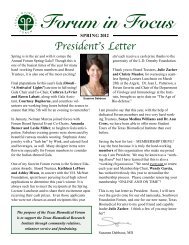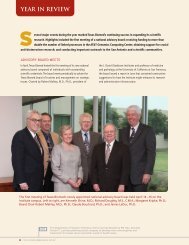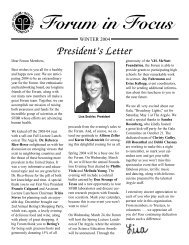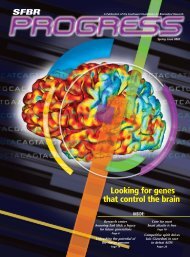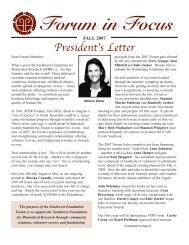Texas Biomed Science Report 2011-2012 - Texas Biomedical ...
Texas Biomed Science Report 2011-2012 - Texas Biomedical ...
Texas Biomed Science Report 2011-2012 - Texas Biomedical ...
Create successful ePaper yourself
Turn your PDF publications into a flip-book with our unique Google optimized e-Paper software.
Laura Cox, Ph.D.<br />
Associate Scientist, Genetics<br />
The focus of Cox’s research is the identification and characterization<br />
of genes involved with development of cardiovascular disease. The<br />
goal of these studies is to identify genetic and epigenetic variations<br />
in response to diet and in response to the maternal environment<br />
that influence the atherosclerotic process. In previous work Cox<br />
and her colleagues constructed a second-generation baboon<br />
genome map. Using the baboon linkage map in conjunction with<br />
a novel expression array approach, Cox has positionally cloned<br />
and characterized a gene that influences HDL-cholesterol.<br />
Furthermore, her team has identified molecular genetic mechanisms<br />
by which variation in this gene influences variation in HDL-cholesterol.<br />
Her research team is also using new “next generation” sequencing<br />
methods and new analytical tools to identify genetic networks that<br />
influence LDL-cholesterol and salt-sensitive hypertension. Another<br />
area of study in her lab is analysis of genetic and epigenetic responses<br />
to the maternal environment and the impact on offspring health with<br />
the long-term goal of determining how the maternal environment<br />
influences adult risk of heart disease. Each genetic network and<br />
Staff<br />
Left to right: Genesio Karere, Shifra<br />
Birnbaum, Jerry Glenn, Laura Cox,<br />
Kenneth Lange, Kimberly Spradling,<br />
Natalia Kuhn, Clint Christensen<br />
<strong>2011</strong>–<strong>2012</strong> Scientific <strong>Report</strong><br />
“Research by multiple investigators indicates that entire transcriptional networks play roles in genetic<br />
responses to environmental challenges. Our goal is to identify network responses to dietary fat that<br />
differ in individuals with good cholesterol profiles versus bad cholesterol profiles. Identification<br />
and understanding of the mechanisms by which these networks are regulated will provide<br />
RNA-based therapeutic targets for prevention of atherosclerosis.”<br />
Publications<br />
• Holmes RS, Vandeberg JL, Cox LA (<strong>2011</strong>) Comparative studies of vertebrate lipoprotein<br />
lipase: a key enzyme of very low density lipoprotein metabolism. Comp Biochem Physiol<br />
Part D Genomics Proteomics 6:224-34.<br />
• Antonow-Schlorke I, Schwab M, Cox LA, Li C, Stuchlik K, Witte OW, Nathanielsz PW,<br />
McDonald TJ (<strong>2011</strong>) Vulnerability of the fetal primate brain to moderate reduction in<br />
maternal global nutrient availability. Proc Natl Acad Sci USA 108:3011-6.<br />
• Kamat A, Nijland MJ, McDonald TJ, Cox LA, Nathanielsz PW, Li C (<strong>2011</strong>) Moderate global<br />
reduction in maternal nutrition has differential stage of gestation specific effects on<br />
{beta}1- and {beta}2-adrenergic receptors in the fetal baboon liver. Reprod Sci 18:398-405.<br />
• Karere GM, Glenn JP, VandeBerg JL, Cox LA (2010) Identification of baboon microRNAs<br />
expressed in liver and lymphocytes. J <strong>Biomed</strong> Sc. 17:54.<br />
• Nijland MJ, Mitsuya K, Li C, Ford S, McDonald TJ, Nathanielsz PW, Cox LA (2010) Epigenetic<br />
modification of fetal baboon hepatic phosphoenolpyruvate carboxykinase following<br />
exposure to moderately reduced nutrient availability. J Physiol 588(Pt 8):1349-59.<br />
• Cox LA, Glenn J, Ascher S, Birnbaum S, VandeBerg JL (2009) Integration of genetic and<br />
genomic methods for identification of genes and gene variants encoding QTLs in the<br />
nonhuman primate. Methods 49:63-9.<br />
gene variant that is identified will provide potential therapeutic<br />
targets for modulation of blood pressure and serum cholesterol.<br />
E For more information, please visit www.txbiomed.org/departments/<br />
genetics/genetics-staff-bio?u=35<br />
13




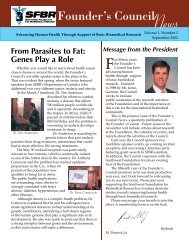
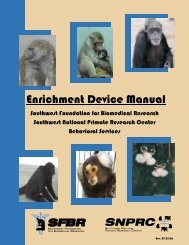
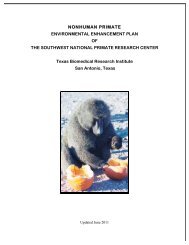
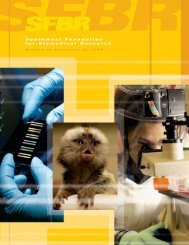
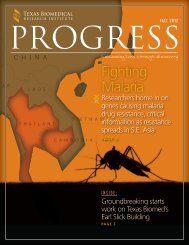
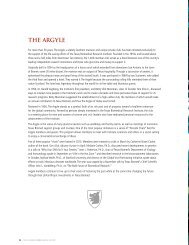
![Vol. 8 No. 2, 2011 [PDF] - Texas Biomedical Research Institute](https://img.yumpu.com/35688099/1/190x245/vol-8-no-2-2011-pdf-texas-biomedical-research-institute.jpg?quality=85)
